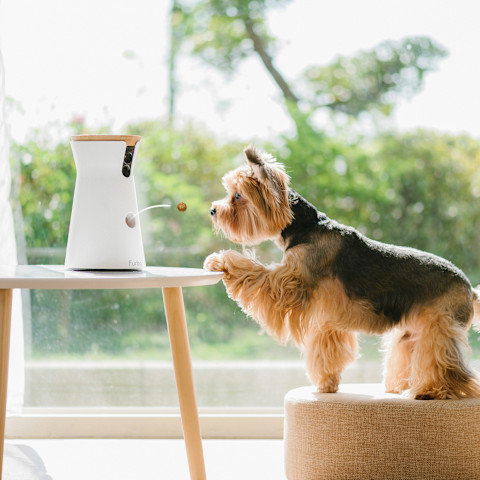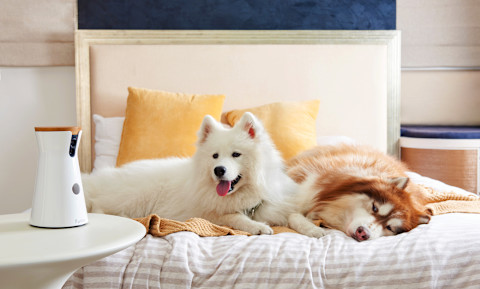
There’s no bond quite like the one we have with our dogs. And just like us, our pups can get stressed, anxious, or uncomfortable in certain situations. The tough part is not always knowing how to make them feel better—belly rubs and bacon treats aside, of course.
So we spoke with certified dog trainer and behavioral expert Andrea Arden on some of the reasons why a dog might feel off her game, and what we can do to help and connect even better with man’s best friend.
Here’s how to help your dog deal…
1. …while home alone
Being alone at home is a hard concept for dogs to get used to, especially because they’re highly social creatures. It’s not any easier on the dog parents, who worry about boredom, separation anxiety, and safety, including destructive behaviors, when they leave their four-legged family members at home for long periods of time.
“I’ve been working with dogs and their families for 25 years and in the last 15 years, people’s lives have gotten busier; they’re not home with their dog as much,” says Arden. “But now, people understand how important it is to provide for their dog’s emotional well-being and give their dog something to do when they’re not home.”

The Furbo Dog Camera lets owners see, talk with, and toss treats to their dog when they’re away from home. And it’s not just the treat-tossing that makes it different (and more pup-approved) than any other home monitor system—Furbo is the only camera specifically designed for dogs and can alert you when she’s showing signs of boredom or separation anxiety, like barking or chewing on furniture, so you can engage right away.
“Trainers tell people that being engaged with your dog—actively participating in their learning and their physical and mental exercise—isn’t just fun for you,” Arden says, “it’s also important for your dog to stay physically and behaviorally healthy.”
2. …in a new environment
It’s not uncommon for dogs to get frazzled in unfamiliar territory—any dog parent who’s walked their pup near a subway grate gets it.
“The best response any time your pup is saying, ‘I don’t feel good in this situation’ is to immediately try to make the dog feel more comfortable,” says Arden. If she’s showing signs of unease or barking at an inanimate object like a big mirror or a staircase, “just walk over to the object and touch it and stand there, and they will follow and understand it’s not a threat.”
Exposing your dog to as much of the world as possible (a training term known as habituation), especially if she’s a new addition to the family, definitely helps. Dogs are very specific learners, so what they learn in one context—like puppy school—may not apply in a different environment. “That’s why service dogs spend literally a year learning the most basic training focusing on socialization and habituation,” says Arden, “so you don’t a service dog who’s easily spooked at anything.”
3. …around a dog she doesn’t like
Your dog might not get along with every other canine she comes across, and that’s actually normal. “I’d say usually it’s not because of a past negative or extreme experience, it’s just a preference,” says Arden.
“Dogs are masters at body language,” she says. So, if they can’t see the eyes of a curly-coated dog, they can’t read or pick up on their expression. Same idea with bulldogs that have stiffer body posture, or pugs that sound like they’re growling when they’re just breathing—your dog may just be reacting accordingly to what she perceives.
In this scenario, give your dog distance. Reassure her that she never has to meet the other dog ever again (you’ll always move her away if she does). Saying, “let’s go!” and rewarding her when you walk away will help.
4. …during a thunderstorm

According to Arden, some dogs are just genetically predisposed to thunderstorm phobias, so it’s not something you can easily train your dog to get over. Instead, focus on ways to prevent any stress from escalating to a full-blown panic.
When there’s a storm, keep your dog from running around the house. “The running feeds into the panic and can make her more nervous,” says Arden. A tiled bathroom feels like a safe spot for dogs to hide out, or you can try keeping her on a leash or using a calming vest—the well-fitted material around a dog’s abdomen helps decrease stress “like a hug.”
And if your dog’s showing signs of stress during a storm when you’re not there, Furbo Dog Camera's Smart Alerts let you know what’s going on. The camera recognizes continuous activity from your dog, like constant pacing or licking, and notifies you in real time so you can help calm any anxiety in a fun, positive way. Peace of mind for both of you.
